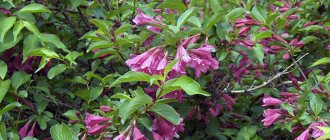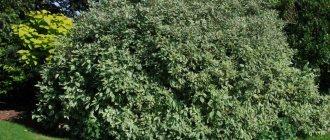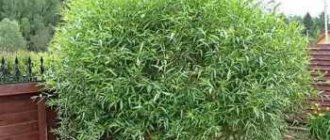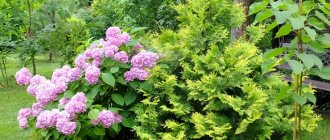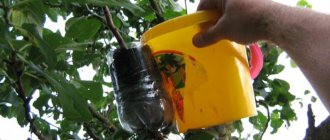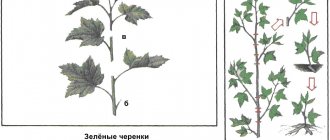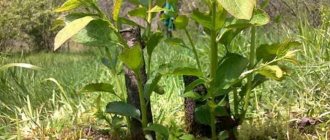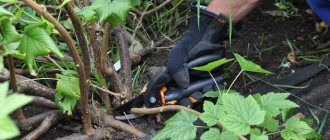The plum can rightfully be called one of the most beloved garden trees by summer residents. It gives its owners delicious and juicy fruits, and in the spring it pleases the eye with lush blooms and a wonderful aroma emanating from its delicate petals. However, in order for the tree to grow healthy and bring the long-awaited harvest at the end of summer, it is necessary to properly care for the seedling. Any mistake, especially in the initial stages, will lead to the death of the plum or the development of a disease. There is no need to be scared, you just need to remember the basic rules for preparing the soil, the planting algorithm and the requirements for further care.
Rules for preparing soil for planting seedlings
Sandy loam or loamy soil is best suited for planting plums. You must first test the soil for acidity. An acceptable value is 6.5-7 units, no more. If the acidity of the soil is unknown, it can be easily determined. To do this you need:
- Prepare litmus paper.
- Take a handful of wet soil (for example, after rain or watering).
- Attach the soil to the piece of paper.
If, as a result of the experiment, the litmus acquired a slight pink tint, this is an indication that the soil is neutral or alkaline. If a bright red color appears on the piece of paper, this indicates increased acidity of the environment. In the second case, the owner of the site needs to alkalize the proposed planting site. To do this, slaked lime is mixed into the ground. As an alternative, you can use dolomite flour.
Often in a summer cottage the soil contains excess sand or peat, which is also not very good for plums. The solution to the problem will be to fill it with clay. The height of its layer should be approximately 10 centimeters - this will be enough to improve the quality of the soil. Other recommendations for preparing the land for planting plums:
- The place should be wide and flat, and the terrain should be undulating.
- You cannot plant a plum in a darkened area; the tree loves light.
- Lowland is a bad choice for seedlings; they will not take root there.
- The roots of the plum tree are distinguished by the fact that they go very deep, so it is strictly forbidden to plant it in an area with high groundwater. Otherwise, the roots will be washed away by water, which will cause the plum to rot and die. If there is no other place for planting, you need to arrange a ridge at least 50-70 centimeters high. The land itself must be drained through ditches.
- You should not try to plant a plum tree in a place where the garden has recently been uprooted. You definitely need to wait 3-4 years for the soil to gain strength and restore its nutrient layer.
The owner of a summer cottage needs to take into account the fact that after planting, every year the flowerbed will have to be expanded by about 10-15 centimeters. This is due to root growth.
Plum propagation
If you learn how to propagate plum trees, you can save on planting material. Reproduction methods:
- By cuttings. This is the easiest way. Cuttings are harvested in early July. Growing order: In the morning or evening, cut a shoot 20-30 cm long. Having cut cuttings from the shoot with two or three leaves, they are immersed in the stimulator for 14-15 hours. When cuttings are cut, one cut is made straight, the other at an angle of 45 degrees.
- The garden bed is located in a shady place. Having mixed peat and sand (1:1), pour the mixture onto the prepared bed in a layer of 10-15 cm. Sand is poured on top - 2-3 cm, and watered with a superphosphate solution (1 tsp per 10 liters of water).
- The cuttings are planted in moist soil, deepened by 3 cm. The interval between cuttings is 6-7 cm. Cover the bed with film, having previously built a wire frame. The optimal temperature in the greenhouse is +25-28 °C.
- The cuttings are watered several times a day, and after 3-4 weeks roots appear. In the winter, the plantings are mulched and insulated, and in the spring they are planted in a permanent place.
- The tree should have a branched crown, a low trunk and a well-developed root system. In September or April, 2-year-old shoots with roots are dug up from it. The shoots are taken in a sunny place, away from the trunk.
- A shoot of a small tree is bent to the ground. And here they make a ditch, its width and depth are 10-15 cm.
- copulation;
What should a seedling be like?
There are several dozen varieties of plums. When choosing, there is a risk of getting confused and ultimately choosing the wrong seedling. To prevent this from happening, when purchasing, you need to give preference to zoned varieties. That is, those that are bred in a specific region. If you buy a variety from another region, for example, a warmer one, the seedling will die due to low temperatures. The same thing will happen in the opposite situation: having acquired a seedling from a colder region and planted it, you should not be surprised why it did not take root in a hot climate. The second important point is the place of purchase. It is recommended to purchase plums from specialized gardening and flower shops. The quality of seedlings sold in markets and privately is usually questionable. The owner must also decide how the plum will be pollinated. There are varieties adapted for self-pollination. Some plums, on the contrary, can only be pollinated by other trees. The choice in this case depends not only on personal preferences, but also on the size of the summer cottage and the amount of free space on it.
And finally, it is important to carefully examine the selected seedling:
- Check how well the rhizome is developed. Under normal conditions, it will have 4-5 processes 25 or more centimeters long.
- Pay attention to the thickness of the trunk. It should be 1-2 centimeters. Deviations of 1-2 millimeters are acceptable, this is not critical.
It is recommended to buy seedlings 1-2 years old. This is the best option for planting.
Diversity of species of the subgenus Prunus
To this day, wild plums can be found in forests, along ravines and ravines, but most species belonging to this subgenus have long been domesticated. They produce rich harvests of medium and large fruits of different colors with a characteristic flat stone inside. Their length is usually 1.5 times greater than their thickness, and their diameter is from 1–3 cm. New varieties have been developed that produce large fruits up to 8 cm in size, sweet or sour in taste. Species common in Eurasia:
— Home garden is a common species for central Russia.
— Prickly, blackthorn, blackthorn - a small, very prickly shrub with blue fruits.
- Spreading cherry plum is a tree reaching a height of 8 m. It grows wild in the Caucasus and Central Asia.
— Ussuriyskaya — lives wild in Primorye and is cultivated for its fruits in Eastern Siberia.
— Chinese — grown in China, Japan, Korea. The fruits are sweet and sour and are widely used in cooking and winemaking.
— Pissardi is an ornamental tree with beautiful pink petals and dark red foliage. Used in landscape design.
When you see a thorn bush, you are perplexed: is it really a plum? Berry or fruit - its dark blue small fruit? Cherry plum also surprises with its fruiting. Although this tree looks like a plum, the color of its rich harvest is unusual - red and yellow (purple and blue fruits are less common).
Plum orchard planting plan
When the plot of land has been prepared and the seedlings have been purchased, you can begin planting. As mentioned above, plums love light, so nothing should cast a shadow on the chosen planting site. If several trees are planted at once, it is necessary to place them at a distance of several meters from each other. The landing algorithm looks like this:
- Dig a hole for the seedling within a week.
- Straighten the roots of the seedling and place it in the prepared hole. In this case, the root collar should rise above the ground level by 2-5 centimeters.
- Cover the young plum with soil. There is no need to add fertilizers.
- Compact the soil thoroughly. This is necessary in order to protect the roots from the penetration of excess air, otherwise they will dry out.
- Place the soil remaining after preparing the hole (that is, taken from its bottom) around the plum. The embankment will create a fertile layer that absorbs excess water during irrigation or rain.
- Then tie the tree to the stake.
At the very end, when the plum is planted, the owner must water the young beauty generously. However, it is important not to overdo it. You should not create a swamp - the roots will not cope with so much water and will rot.
How to choose suitable seedlings
A gardener has three ways to purchase planting material:
- In the nursery, where you can buy varietal seedlings and pollinators. There you can also get the necessary advice on the characteristics of the variety and how to plant plums. When choosing a seedling, be guided by the picture presented. If you can choose a plant with an open root or in a container, it is better to choose an open one. It clearly shows all the nuances of development. The root should be in a clay mash.
- You can get free planting material using cuttings. Take young branches that have turned red from the mother plant, carefully separate them and keep them in water for 10 days. Callus will appear. Root the branches in a substrate of sand and peat, watered with phosphated water. The roots will grow in 10-40 days. By the time stable frost sets in, cover the shoots completely with peat and leave them for the winter.
- Grow a seedling from a seed.
Any seedling must be no older than 2 years. When planting, the buds should be swollen, but not open. You cannot buy a seedling with dry buds in the spring - it has been exposed to frost. Autumn planting is carried out 1.5 months before persistent frosts.
In autumn, the seedling is not pruned. In the spring, you need to shorten the branches so that the weak root system can feed a small amount of ground mass. The rule is this: the weaker the root system of the seedling, the more shoots need to be pruned, while simultaneously forming the crown.
The fruit pit is prepared in advance, filled with a substrate of humus, phosphorus-potassium fertilizers and fertile soil by half. The roots are placed along the mound and carefully covered with ordinary top soil. This compacts the soil to force out the air. The root collar should remain above the planting level, but be sprinkled. Later the tree will settle. After planting, pour several buckets of water into a fresh hole and mulch. A stake is installed on the north side to which the seedling is tied. Caring for plums after planting consists of timely watering and loosening the soil.
Temperature
The climate in which plums will grow comfortably depends on the specific variety. You need to choose those varieties that were bred in a particular region. If you start experiments, they will not lead to anything good. Heat-loving plants will die in a colder location, while cold-tolerant trees will do poorly in the heat. In addition, it is important to remember that plum trees do not like winds. It is better to plant it in such a way that the tree is protected from gusts of wind by a fence, gazebo or the country house itself. Compliance with humidity conditions plays an equally important role. Even heat-loving varieties do not tolerate drought well. In such weather circumstances, you need to take care of the drain and provide it with sufficient watering, but at the same time observe the measure and not waterlog the soil.
How and what to fertilize before planting
Before planting, you need to make sure that the soil is fertile. Even a healthy and well-bred seedling will wither in poor soil. To prepare fertilizer (substrate) use:
- humus or compost - 2 buckets;
- peat - 2 buckets;
- superphosphate – 1 tbsp. spoon;
- potassium sulfate – 3 tbsp. spoons;
- urea – 3 tbsp. spoons.
All components are mixed and poured into the bottom of the dug hole. In addition, you can prepare an alternative mixture - simpler, but no less effective. You will need wood ash (200 grams) and nitrophoska (2 cups). If the owner does not have wood ash, it can be replaced with dolomite flour or fluff lime. The quantity is the same - 200 grams. If, when testing the soil with litmus paper, increased acidity (bright red color) was detected, then it is worth adding calcium ammonium nitrate. This product will fill the soil with nitrogen and level out the acidity level.
At what depth to plant
The pit for planting a seedling must be prepared in advance. The optimal period is one week. With a diameter of 70-80 centimeters, the suitable depth will be 70 centimeters. It is recommended to adhere to the specified values. If necessary, you can loosen the soil. Loosening depth is 20-25 centimeters (if the soil is too heavy). You need to add ground eggshells to the bottom, as well as a little more than half of the prepared substrate. Also, do not forget to stick a peg to which the plum will then be tied.
Care after landing
Caring for a plum tree after planting includes 5 main procedures:
- watering;
- crown trimming;
- loosening;
- mulching;
- treatment for parasites.
Watering and pruning will be discussed separately. As for loosening, it should be done after each watering or heavy rain. The procedure allows the roots to be saturated with oxygen and, as a result, the tree grows faster. Mulching prevents the rapid evaporation of the necessary moisture and protects the area from the growth of weeds. Mulch also feeds the soil with micro- and macroelements useful for plums. The mulch should be laid out so that it does not touch the trunk, but only touches the ground above the rhizome.
In general, plums are unpretentious in care compared to other fruits. But, like all fruit trees, it is susceptible to attack by various parasites. These include:
- scale insect;
- false scale insect;
- mites;
- aphid;
- caterpillars;
- codling moth.
The susceptibility to certain diseases is determined by the type of tree. Before planting, the owner of the cottage should familiarize himself with the most common diseases of the selected type of plum. Recommendations for protecting and preventing plums from pests:
- Inspect trees regularly.
- Trim and burn diseased branches, leaves and fruits.
- In spring, treat plums with chemicals.
- A 1% solution of Bordeaux acid works well against parasites. The tree should also be sprayed with it in the spring. As an alternative, a 4% polycarbocin solution can be used.
- Karbofos 0.2% concentration helps in the fight against aphids and codling moths.
All of the above products can be easily purchased at gardening and flower shops.
Spring plum care
In spring, not only trees wake up, but also insect pests and disease spores. Therefore, plum care in the spring begins with preventative spraying with copper sulfate. You can carry out the first spraying with nitrofen to destroy wintering ticks. In addition, trapping belts are installed, tree trunks are whitened with insecticides added to lime. To protect the plum, you will need to treat it four times with copper sulfate of 1% strength:
- on swollen kidneys;
- along the green cone;
- by flower buds;
- a week after flowering.
Preventive treatments are carried out to destroy colonies of pests overwintering in the garden.
In order for the tree to direct its forces to the formation of a harvest, the plum is pruned in the spring according to the scheme for a young and fruit tree. The purpose of pruning a seedling is the correct formation of the crown, creating the correct ratio of the central shoot and fruit tiers. At the same time, skeletal branches are formed and unnecessary interlayer formations are removed. Pruning is done in such a way as to force dormant buds to work, because the entire harvest occurs only on young growth.
An adult plum tree undergoes sanitary and thinning pruning. After spring formation through the branches, the sparrow should fly in a straight line in all directions.
The tree had just begun sap flow, and a portion of natural organic matter was added to the trunk circle of an adult tree. Caring for plums in the spring ensures that the tree regains its strength after wintering. Therefore, fertilizing and abundant spring watering are necessary measures. When watering, add ammonium nitrate according to the calculation of a matchbox to a bucket of irrigation water. Careful attention to the tree will protect it from weevils and other misfortunes.
Pruning and crown formation
The very first pruning should be done after the plum is planted on the site. The owner must determine by visual inspection the strongest and strongest branches. A crown is formed from them - several tiers of 5-6 branches each. It is also important to mark the conductor and cut it so that it is the longest. The tiers should be arranged like this - the longest branches at the top, the shortest at the bottom. Pruning should be done every year to maintain a neat appearance of the crown. In addition, young trees are distinguished by the fact that they often grow extra branches. They must be cut so that the branches do not shade each other and interfere with the normal growth of the plum.
Preventive pruning is carried out in the spring. Usually this is April-May. Remove old and winter-damaged branches. They are then burned to prevent the proliferation of parasites.
Tree pruning
Pruning is necessary to increase frost resistance, form the crown and prevent its thickening, and give the tree a beautiful appearance. Plums can grow a lot of extra branches, thickening the crown and reducing yield. Regular pruning helps correct the situation.
Requirements
Rules for pruning plum trees:
- Pruning is carried out in spring, autumn and summer. Some gardeners also carry out winter pruning, but it is specific and unsafe for the tree. The best time for pruning is spring.
- Young seedlings are pruned minimally; pruning is aimed mainly at crown formation.
- Varieties with weak branching shorten less than strongly branching plums.
- When the tree begins to bear fruit, pruning is carried out only as a last resort.
- Most often, the plum forms a cup-shaped crown.
Tools needed for cutting:
- garden knife;
- garden saw;
- pruner
All cutting parts must be well sharpened to ensure even cuts. All instruments are cleaned and disinfected.
Spring pruning
Spring is the most favorable time for pruning. It is carried out at the end of March or at the beginning of April, before the sap flows. During the first three years of life, the tree’s crown is formed; if time is missed, the branches will grow beyond measure, become entangled and interfere with each other.
In spring, all shoots that are growing incorrectly and old branches that do not bear fruit are clearly visible. Spring pruning rules:
- In the first year of life, all side shoots of the tree are cut off, and the main conductor is cut off so that the height of the seedling is 60 cm.
- In the second year, the main conductor is cut to 40-50 cm, along with the upper bud located above the cut. At the bottom, the side branches are cut off almost completely, leaving stumps 7 cm long. All other side shoots are cut off by 1/3 of the length. The angle of inclination of the skeletal branches should be 50-60 degrees.
- In the third year, 6-8 skeletal branches are selected, all others are removed. No more than 4 buds are left on the remaining branches.
In the future, spring pruning comes down to maintaining the given crown shape:
- Remove all branches that grow incorrectly - inside the crown or located at an obtuse angle.
- If the crown is lush, it is thinned out and old branches are removed.
- Last year's growth is shortened - this helps the tree to form new fruit branches.
- Remove branches that are broken and frozen over the winter, as well as those on which birds have damaged the buds.
Pruning is carried out in clear, calm weather, at a temperature of at least +10 °C.
Summer pruning is applicable only to young trees; it is harmful for adults, and is carried out only if absolutely necessary - for example, when diseased branches are detected.
Autumn pruning
Autumn pruning is carried out after leaf fall - from about mid-September. It is necessary to leave enough time between the procedure and frost - the tree must get stronger after stress. Autumn pruning is carried out mainly in regions with warm climates. In regions with harsh winters, it is preferable to prune in the spring.
Autumn pruning scheme:
- Remove all diseased, dry and broken branches.
- The main conductor is cut off if it becomes too long during the growing season.
- Fast-growing, competing shoots that thicken the crown are pruned. All cut branches are burned.
Depending on the age of the tree, the pruning order changes:
- In the first year of life, in the fall, the main conductor is cut off by 1/3, other branches by 2/3.
- Regardless of age, thin out the crown and remove incorrect and rapidly growing branches.
- After 4-5 years of life, anti-aging pruning is carried out. The frequency of such procedures is once every 4-5 years.
Fertilizer requirements for plum trees
Plum does not need frequent fertilization of the soil. It only needs the nutrient layer that is laid at the bottom of the hole before planting. In the first year, the tree does not need to be fertilized additionally. Starting from 2-3 years of age of plums, you need to mix humus into the soil. It is recommended to add potassium sulfate and superphosphate to it. The proportion per 1 square meter will be: half a bucket of compost + 50 grams of superphosphate + 20 grams of potassium sulfate. In spring, plums are fertilized with ammonium nitrate. 20 grams of product are required per 1 square meter. After flowering, the plant also needs to be fed. Green broths and natural organics are suitable for this. The recipe for the mixture is simple: dilute 2 tablespoons of urea + 3 nitrophoska in a bucket of water.
Approximate composition and calorie content of plums
The calorie content of plum fruit is 46 kcal per 100 g of pulp. The amount of ballast substances is 1.4 g.
Macronutrients:
- water - 87%;
- carbohydrates - 7.4%;
- fats - 0.1%;
- proteins - 0.6%.
Vitamins:
- C - 9.5 mg;
- E - 0.39 mg;
- B1 - 28 mcg;
- B2 - 26 mcg;
- B3 - 0.42 mg;
- B5 - 0.14 mg;
- B6 - 29 mcg;
- folic acid - 5 mcg;
- A - 17 mcg;
- K1 - 6.4 mcg.
Minerals:
- calcium - 6 mg;
- potassium - 0.16 g;
- magnesium - 7 mg;
- zinc - 0.1 mg;
- iron - 0.17 mg;
- iodine - 1.8 mcg;
- phosphorus - 16 mg;
- copper - 57 mcg;
- manganese - 52 mcg.
Fatty acid:
- saturated - 17 mg;
- simple unsaturated - 0.13 g;
- polyunsaturated - 44 mg.
Don't forget about watering
Watering is one of the fundamental points when growing plums. The tree does not tolerate drought, so the soil must be well moistened. Watering should be done regularly, but local climatic conditions should be taken into account. Excess moisture will lead to rotting of the roots and subsequent death of the tree. During hot weather, the plum tree should be watered weekly. The approximate water consumption is 40 liters for a young seedling or 60 liters for an adult plum.
Harvesting
The long-awaited harvest takes place at the end of summer. There are several rules to follow when harvesting plums:
- Fruits can only be collected in dry weather, since wet plums are stored for much less time.
- The fruit must be picked immediately after it is formed. Overripe plums quickly rot.
- You need to choose healthy fruits that are not damaged by parasites.
- Collection should begin from the lower branches, gradually moving to the top.
- Harvesting is carried out in several approaches, since the plum ripens unevenly.
Each owner decides for himself what to do with the harvest. It can either be consumed immediately, or prepared for the winter in the form of, for example, jam.
Early varieties
Early varieties of plums allow you to enjoy your favorite fruits until mid-August. They are very juicy, but not overly sweet. Let us describe some representatives of this group.
Eurasia
- This is a hybrid obtained by Russian breeders. "Eurasia" is one of the varieties of Plum Domashnaya. A plant with early ripening berries.
- The harvest begins in early August in the 5th year of the plant's life. Under good weather conditions and care, 1 tree can produce 50 kg of berries.
- The harvest must be harvested immediately after ripening, as plums quickly begin to fall from the tree. The variety is not suitable for transportation.
- The tall tree can reach a height of up to 6 m. The fruits after ripening acquire a dark burgundy color. They taste sweetish, with sourness. The weight of one of them is on average 30 g. The pulp of the berries is granular. The plum is orange when cut.
- Can tolerate cold temperatures down to -20 °C. The tree takes root easily after planting.
“Eurasia” is not capable of pollinating on its own.
It is recommended to plant the following next to it:
- Volga beauties
- Memory of Timiryazev
- Renklod Kolkhozny
- Lighthouse
- The Golden Fleece
Starting
- Obtained by crossing plums Eurasia and Volga beauty. It is considered an extremely early variety.
- The tree begins to bear fruit 2-3 years after planting. The berries are purple, weighing up to 60 g.
- Ball-shaped. The fruits are red when cut, juicy. The seed is easily separated from the pulp.
- “Startovaya” tastes sweet, but has a sour aftertaste. They can be consumed in any form. They tolerate transportation well.
- The variety is zoned in the central part of the country. It is considered a cold-resistant plant. But it grows and bears fruit best in areas with slight drops in air temperature in winter.
- The plant is self-sterile. High yield rates are shown only when there are pollinator trees nearby.
Preparing plums for winter
Young plum seedlings do not tolerate cold weather well, so special attention must be paid to preparing the trees for winter. First of all, you should carefully dig up the soil to saturate it with oxygen. Then take care of the crown - tie it to a stable stake, and collect the branches themselves into a single broom. This is necessary to protect young branches from strong winds, which can be very gusty in winter. If the plum was planted in the spring, it needs to be buried under the snow. If the tree is older, it is still recommended to wrap its trunk with snow and also cover it with additional hay. If the plum tree has grown and has many branches, they all need to be strengthened with pegs. Such support will support young branches and prevent them from breaking under the weight of snow.
Article Rating


